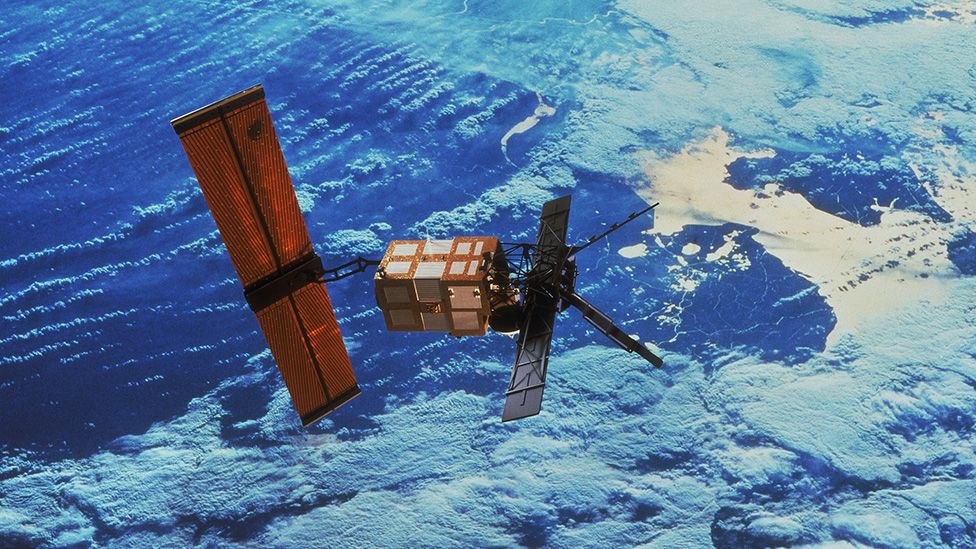ARTICLE AD BOX
 Image source, ESA
Image source, ESA
Artwork: Europe's Earth Remote Sensing satellites weighed about 2.5 tonnes at launch
A pioneering European satellite is due to fall to Earth in the coming hours.
ERS-2 was a cutting-edge observation platform when it launched in 1995, forging technologies that are now used routinely to monitor the planet.
It's been gradually descending since ending operations in 2011 and will take an uncontrolled, fiery plunge into the atmosphere some time on Wednesday.
The European Space Agency (Esa) says most of the two-tonne satellite will burn up on the way down.
It's possible some more robust parts may withstand the intense heating generated during the high-speed dive, but the chances of these fragments hitting populated areas and causing damage are slim.
They could land almost anywhere in the world but with most of the Earth's surface covered by ocean, whatever debris survives to the surface is most likely to be lost at sea.
"And it's worth highlighting that none of the elements that might re-enter the atmosphere (and reach the surface) are radioactive or toxic," said Mirko Albani from Esa's Earth Observation Ground Segment Department.
Image source, ESA
Image caption,Sea-surface temperature: Today's climate monitoring owes a debt to the ERS programme
The agency launched two near-identical Earth Remote Sensing (ERS) satellites in the 1990s. They were the most sophisticated planetary observers of their day, carrying a suite of instruments to track changes on the land, in the oceans and in the air.
They monitored floods, measured continental and ocean-surface temperatures, traced the movement of ice fields, and sensed the ground buckle during earthquakes.
And ERS-2, specifically, introduced a new ability to assess Earth's protective ozone layer.
"Absolutely," said Dr Ralph Cordey. "In terms of technology, you can draw a direct line from ERS all the way through to Europe's Copernicus/Sentinel satellites that monitor the planet today. ERS is where it all started," the Airbus Earth observation business development manager told BBC News.
ERS-2 is the first of the duo to come home. Originally placed 780km above the Earth, engineers used its final fuel reserves in 2011 to lower its altitude to 570km. The expectation was that the upper atmosphere would then drag the spacecraft down to destruction in about 15 years.
Image source, AIRBUS
Image caption,Germany's Dornier company (now Airbus) led the assembly of the ERS satellites
This prediction will hold true on Wednesday evening, GMT.
Precisely when and where is difficult to say. Much will depend on the density of the upper atmosphere, something which is influenced by solar activity.
What can be said with certainty is that the re-entry will occur between 82 degrees North and South, as this was the extent of the satellite's orbit around the Earth.
Image source, HEO
Image caption,Australian tracking company HEO is following the descent of ERS-2
Those fragments that do impact the planet might include internal panelling and some metal parts, such as fuel and pressure tanks.
The element with potentially the highest probability of making it through the atmosphere in some form is the antenna for the synthetic aperture radar system, which was built in the UK. The antenna has a carbon-fibre construction that can tolerate high temperatures.
When ERS-2 was launched, the space debris mitigation guidelines were much more relaxed. Bringing home a redundant spacecraft within 25 years of end of operations was deemed acceptable.
Esa's new Zero Debris Charter recommends the disposal grace period now not exceed five years. And its future satellites will be launched with the necessary fuel and capability to propulsively de-orbit themselves in short order.
The rationale is obvious: with so many satellites now being launched to orbit, the potential for collisions is increasing. ERS-1 failed suddenly before engineers could lower its altitude. It is still more than 700km above the Earth. At that height it could be 100 years before it naturally falls down.
Image source, ESA
Image caption,California's Hayward fault: ERS pioneered radar interferometry and the mapping of rock movement
The American company SpaceX, which operates most of the functional satellites currently in orbit (more than 5,400), recently announced it would be bringing down 100 of them after discovering a fault that "could increase the probability of failure in the future". It wants to remove the spacecraft before any problems make the task more difficult.
Last week, the Secure World Foundation, an advocacy group for the sustainable use of space, and LeoLabs, a US company that tracks space debris, issued a pressing statement on the need to remove redundant orbital hardware.
They said: "The accumulation of massive derelict objects in low Earth orbit continues unabated; 28% of the current long-lived massive derelicts were left in orbit since the turn of the century.
"These clusters of uncontrollable mass pose the greatest debris-generating potential to the thousands of newly deployed satellites that are fuelling the global space economy."

 11 months ago
32
11 months ago
32








 English (US) ·
English (US) ·